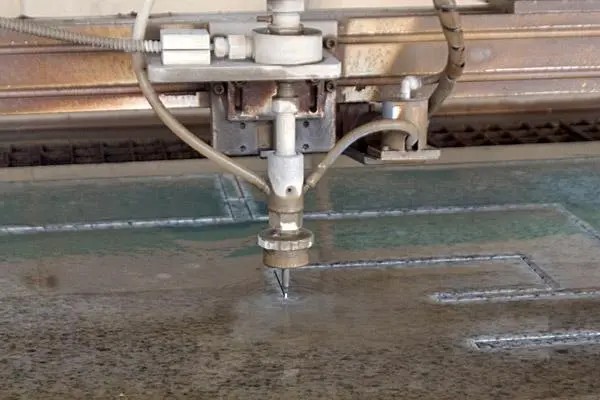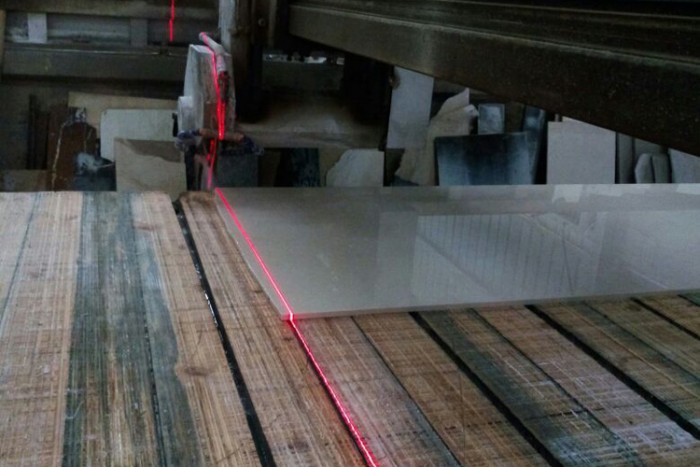How is ultra-thin stone processed?
Ultra-thin stone processing is a high-precision, high-tech stone processing method that is widely used in the fields of construction and decoration. The approach involves a variety of techniques including waterjet cutting, laser cutting, grinding, and polishing, each with unique advantages and suitable for specific scenarios. In this article, we will take an in-depth look at the different methods and characteristics of ultra-thin stone processing, illuminating the complexities of this specialized field.
Water Jet Cutting
Waterjet cutting is an efficient and widely used method for processing ultra-thin stones. This advanced technology uses the power of high-pressure water flow combined with abrasives to achieve precise and intricate cuts in stone. Waterjet cutting has many advantages, including fast cutting speed, high precision, and a smooth cutting surface, making it ideal for a variety of stone processing applications.
One of the main advantages of waterjet cutting is the ability to cut ultra-thin stones quickly and accurately. High-pressure water streams, often combined with abrasive substances, are capable of cutting stone with great speed and precision. This makes waterjet cutting particularly suitable for projects requiring complex designs and complex shapes, as it allows for detailed and precise cuts without compromising the integrity of the stone.
Additionally, waterjet cutting is suitable for stones of various hardness levels, making it a versatile and adaptable method for processing a variety of stone materials. Whether working with softer or harder stones, waterjet cutting consistently delivers high-quality cuts without causing damage to the material.
Another significant advantage of waterjet cutting is its ability to maintain the original characteristics of the stone. Unlike other cutting methods that create heat-affected zones, waterjet cutting does not generate excessive heat, preserving the natural character and integrity of the stone. This is especially important in the processing of ultra-thin stone, where maintaining the original properties of the material is essential to achieve the desired aesthetic and structural effect.

Laser Cutting
Laser cutting is a very advanced and efficient method for processing ultra-thin stones. This cutting-edge technology uses laser beams to precisely cut stone, offering many advantages such as fast cutting speed, high precision, and smooth cutting surfaces. Laser cutting is suitable for stones of various hardness levels and enables precise cutting, making it ideal for a variety of ultra-thin stone processing applications.
One of the main advantages of laser cutting is its exceptional precision and efficiency. The focused laser beam cuts ultra-thin stone quickly and accurately, allowing complex and detailed designs to be achieved with incredible speed and precision. This makes laser cutting particularly suitable for projects requiring a high degree of complexity, as it allows for detailed and precise cuts without compromising the integrity of the stone.
Additionally, laser cutting is suitable for stones of varying hardness, making it a versatile and adaptable method for processing a variety of stone materials. Whether working with softer or harder stones, laser cutting always provides a high-quality cut without causing damage to the material.
Another significant advantage of laser cutting is that it can achieve high-precision processing of stone, ensuring the quality and accuracy of the processing results. This method enables smooth, clean cuts resulting in a refined, polished surface finish. This is especially important in the processing of ultra-thin stone, where maintaining the original properties of the material is essential to achieve the desired aesthetic and structural effect.
Additionally, laser cutting enables the cutting of complex shapes, providing versatility and flexibility in design possibilities. Its ability to precisely cut stone into complex custom shapes makes it a valuable tool for a variety of ultra-thin stone processing applications.

Grinding and Polishing
Grinding and polishing play a vital role in the surface treatment of ultra-thin stone and are essential steps in the entire stone processing process. This common method uses a diamond polishing pad to grind and polish the surface of the stone, resulting in a smooth, shiny surface. The application of grinding and polishing technology enhances the decorative effect of stone and improves the ornamental value and texture of stone. In the field of ultra-thin stone processing, grinding and polishing are indispensable links and make a significant contribution to the overall quality and value of stone products.
The grinding and polishing process involves the use of specialized diamond polishing pads designed to effectively refine and enhance the stone's surface. By using these pads, imperfections, and irregularities in the stone surface can be carefully addressed, resulting in a smooth and flawless surface. This meticulous treatment not only improves the beauty of the stone but also enhances the overall texture and visual appeal of the stone.
One of the key benefits of grinding and polishing in ultra-thin stone processing is the significant improvement in stone decoration. By carefully honing the surface, grinding and polishing techniques enhance the visual appeal of the stone, giving it a lustrous and refined look. This enhanced decorative effect makes the stone more decorative and visually appealing, adding to its overall appeal and appeal in a variety of architectural and decorative applications.
Additionally, grinding and polishing are critical to improving the overall quality and value of your stone products. Meticulous treatment of stone surfaces through grinding and polishing helps create high-quality, refined, and visually stunning stone products. This not only enhances the beauty of the stone but also increases its value, making it ideal for a wide range of architectural and decorative applications.

 English
English  Português
Português  русский
русский  Chinese
Chinese  French
French  Japanese
Japanese  Spanish
Spanish 



